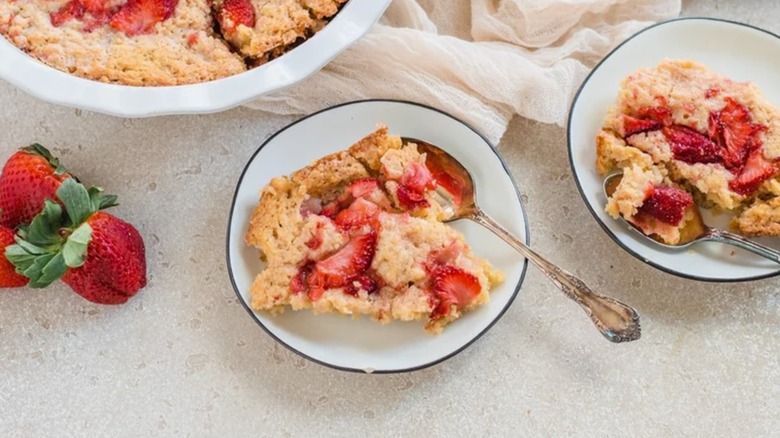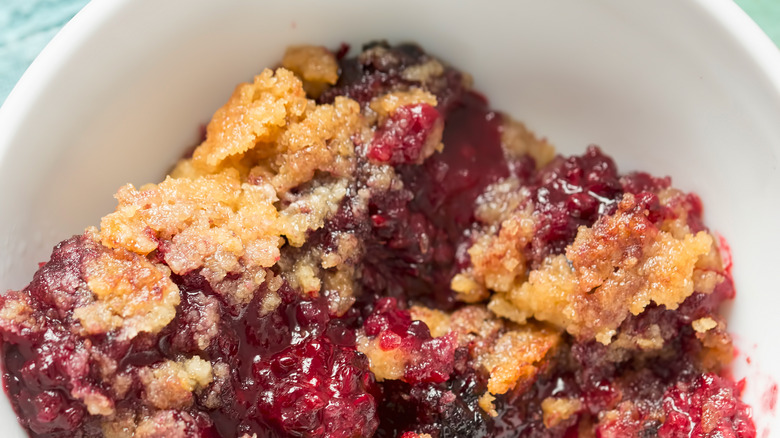Is There A Difference Between Dump And Spoon Cake?
When sweet-toothed foodies hear the words "dump cake" and "spoon cake," the rich, comforting baking sensibilities of the American South are among the first things that probably come to mind. Historically, dump cakes are a Southern confectionery creation invented sometime around the 1960s and 1970s, likely a natural evolution of boxed cake mix gaining popularity in American households. Dry cake mix was invented during the 1930s, and by the 1950s, multiple brands and modern-day dessert giants from Betty Crocker to Pillsbury and Duncan Hines were selling boxed mixes in grocery stores nationwide.
It's unclear exactly when spoon cakes were invented, but they've been enjoyed for centuries, and like dump cakes, they originated in the home kitchens of the American South, where the treat is also colloquially called spoonbread (famously the favorite food of former U.S. President James Monroe).
Their Southern roots are just the beginning of these two comforting classics — and arguably their most compelling similarity. When last-minute guests roll up ready to snack and chill, these cakes are among the quickest, easiest ways for hosts to feed a roomful and enjoy their company, freed from the kitchen. They're also solid treats for new home bakers to get more familiar with baking and yield a successful outcome. Beyond that, dump cakes and spoon cakes present wildly different flavors, textures, ingredients, and assemblies. Most notably, dump cakes are closer to a crunchy cobbler, and spoon cakes are closer to a soft pudding.
What is dump cake?
Forget about a sink full of dirty dishes to wash. With dump cake, the name of the game is minimal active prep time. Just "dump" all the ingredients together in a casserole dish, slam the cake in the oven, and be feeding a crowd within the hour. There isn't even any need to mix the ingredients together (in fact, you shouldn't mix at all). In probably the most well-known dump cake, the pineapple upside-down cake, canned pineapple is topped with a sprinkling of brown sugar, layered with pats of butter, maraschino cherries, and topped with evenly-distributed boxed white cake mix for a fast, reliable, no-stir treat.
These treats can be baked in a casserole dish or cast iron skillet. Unlike pineapple upside-down cake, most dump cakes don't get inverted when removed. They just get scooped up with a large spoon or spatula and served like other soft cobbler desserts.
Dump cakes commonly feature three main elements: Canned fruit or pie filling, dry boxed cake mix, and lots of butter (think 1-2 whole sticks, cut into cold pats and placed evenly across the top of the cake). In dump cakes, the butter and dry cake mix combine to make a crumbly covering atop chewy fruit. But, not always. In chocolate dump cakes, there's no fruity pie filling; the moisture component comes from dry chocolate pudding mix and whole milk, plus chocolate boxed cake mix, chocolate chips, and (of course) butter.
What is spoon cake?
Spoon cakes are ultra moist, and as their name implies, they can be eaten with just a spoon. At its core, spoon cake is a soft, simple cake dotted with baked fruit, like our strawberry spoon cake with fresh berries and brown sugar. Spoon cake is traditionally served still warm from the oven, often topped with cold vanilla ice cream for a hot-cold juxtaposition against the cake's soft, spoonable texture. The cake component is typically some combination of sugar, butter, flour, baking soda, baking powder, salt, cornstarch, and/or vanilla extract, plus whatever fruit the baker selects and a moisture component like buttermilk, vegetable oil, or sour cream. It's comforting and easy to make, scooped into bowls to serve.
Spoon cake also makes a great understated way to showcase seasonal produce. Beyond strawberries, it can be made with peaches, nectarines, plums, blueberries, raspberries, blackberries, halved figs, or halved and pitted cherries. Fruit versions nearly always include lemon zest to emphasize the fruit's natural flavor, while the acidity helps prevent browning and discoloration. Other flavorful batter mix-ins can include pecans, walnuts, cinnamon, nutmeg, and cloves.
Spoon cakes aren't always topped with fruit, either. Variations typically share the same classic vanilla buttermilk cake base, but instead of berries, the cake can be finished with other flavorful toppings like a generous layer of chocolate frosting post-bake. Bakers can also make a chocolate version of the cake by adding cocoa powder and swapping the fruit for chocolate chips.
Dump cake is like a cobbler and spoon cake is like a pudding
The most obvious distinction between dump cakes and spoon cakes — both to the eye and to the palate — is their textures. Dump cakes are essentially the intersection of a cake and a casserole. In dump cakes, leaving the ingredients "dumped" and unmixed is crucial for the cake's textural outcome. In the case of the pineapple upside-down cake, for example, refraining from mixing allows the fruit to gel into a structurally-sound fruit jelly layer topped by a toasty, crumbly outer layer of butter and dry cake mix. The haphazard layering creates a bottom layer of fruit topped with a pastry streusel crust, not unlike a cobbler or crumble dessert. Here, seemingly "no technique" is the technique. Whatever you do, do not mix a dump cake.
Spoon cakes, by contrast, are a cross between a cake and a pudding. Unlike dump cake, spoon cake's assembly more closely resembles typical cake prep. The wet ingredients get folded into the dry ingredients, then transferred to a cake pan, smoothed, and topped with fresh fruit to bake. This difference in construction also affects these desserts' respective heights. While toothy, chewy dump cakes are all about thick stacked layers, thinner, soft spoon cakes are baked in shallower dishes. Unlike dump cakes, spoon cakes only include a standard homogeneous wet batter, which bakes more evenly around the fresh fruit when baked in a wide, shallow baking dish or cast iron skillet.
Dump cakes provide more room for creative flavor pairings, but spoon cakes are a better way to showcase fresh fruit
Considering their different ingredients, it's no surprise that dump cakes and spoon cakes bring some drastically different flavors to the table. Dump cakes are all about pairing boxed cake mix flavors with different types of canned fruit or pie filling. For a quick fall dessert, a home baker could pair canned apple pie filling with yellow cake mix and whip up an apple dump cake. Peach dump cake can similarly be made with just canned peaches in syrup, a box of white cake mix, and cold butter pats. Foodies can even venture into avant-garde pairings with a black forest dump cake (chocolate cake mix over cherry pie filling) or our go-to almond-rhubarb dump cake.
By comparison, spoon cakes are more understated and straightforward flavor-wise. Unlike dump cake's three-part formula (pie filling, cake mix, and butter), spoon cake requires a lengthier lineup of ingredients. Apart from a rotating selection of fresh fruit and the addition of a few spices or nuts, the cake base part remains much the same flavor from one version to the next, leaving less room for mix-and-match taste customization (like our playful cherry cola dump cake). But, spoon cake also provides an opportunity for baking with fresh fruit that doesn't work as well in dump cakes, which rely on syrupy fruits for their richness and texture.




